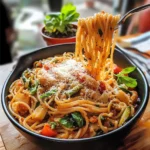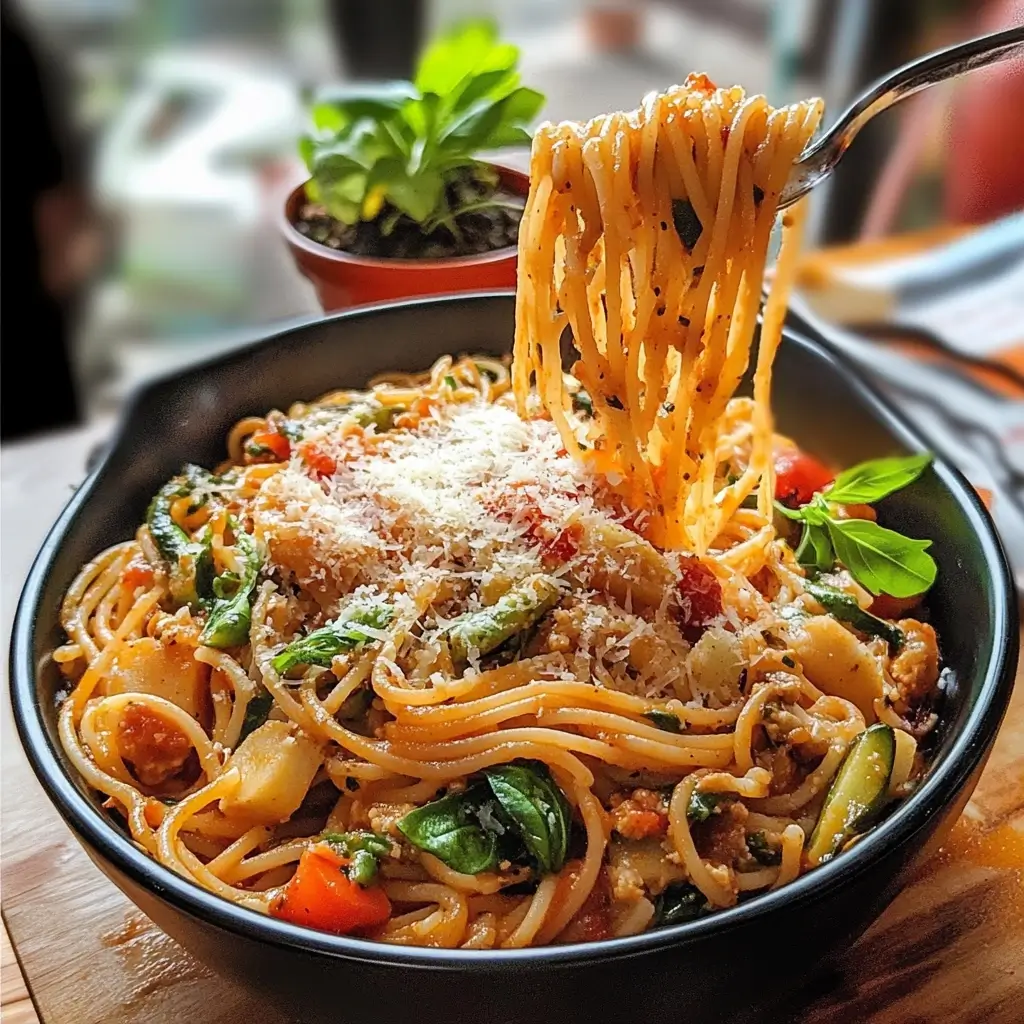This vegetarian spaghetti recipe has become an absolute staple in our household, a go-to comfort food that somehow manages to be both incredibly satisfying and surprisingly healthy. The first time I made it, I was a little skeptical – could a spaghetti sauce without meat truly capture that rich, deep flavor I craved? The answer was a resounding YES! My kids, who can be notoriously picky eaters, devoured their plates and even asked for seconds. My partner, a self-proclaimed carnivore, admitted it was one of the best spaghetti dishes he’d ever had. The secret, I’ve found, lies in layering the flavors of fresh vegetables, aromatic herbs, and good quality tomatoes, allowing them to meld together into a symphony of taste. It’s the kind of meal that fills the kitchen with an irresistible aroma, promising a delicious and wholesome dinner that everyone can enjoy. It’s vibrant, hearty, and proof that plant-based eating can be incredibly delicious and fulfilling.
Ingredients for Hearty Vegetarian Spaghetti
This recipe aims for a rich, umami-packed sauce brimming with vegetables.
- For the Spaghetti:
- 1 lb (450g) spaghetti (whole wheat or regular)
- 1 tablespoon olive oil (for pasta water, optional)
- 1 tablespoon salt (for pasta water)
- For the Vegetarian Sauce:
- 2 tablespoons olive oil, extra virgin
- 1 large yellow onion, finely chopped (about 1 ½ cups)
- 2 medium carrots, peeled and finely diced (about 1 cup)
- 2 celery stalks, finely diced (about 1 cup)
- 1 red bell pepper, stemmed, seeded, and finely diced (about 1 cup)
- 1 green bell pepper, stemmed, seeded, and finely diced (about 1 cup)
- 8 oz (225g) cremini or button mushrooms, wiped clean and chopped or sliced
- 4-5 cloves garlic, minced (about 1 ½ tablespoons)
- 1 teaspoon dried oregano
- 1 teaspoon dried basil (or ¼ cup fresh, chopped, added at the end)
- ½ teaspoon red pepper flakes (optional, for a little heat)
- 1 bay leaf
- 2 tablespoons tomato paste
- 1 (28-ounce / 794g) can crushed San Marzano tomatoes (or good quality crushed tomatoes)
- 1 (14.5-ounce / 411g) can diced tomatoes, undrained
- ½ cup vegetable broth (or water, or red wine for deeper flavor)
- 1 teaspoon sugar or maple syrup (optional, to balance acidity)
- Salt and freshly ground black pepper to taste
- ½ cup cooked brown or green lentils (optional, for added protein and texture)
- 2 cups fresh spinach, roughly chopped (optional, stirred in at the end)
- For Garnish (Optional):
- Fresh basil leaves, chopped or torn
- Fresh parsley, chopped
- Nutritional yeast or vegan Parmesan cheese (or regular Parmesan if not strictly vegan)
- A drizzle of good quality extra virgin olive oil
Instructions
Follow these steps carefully to build layers of flavor for the most delicious vegetarian spaghetti.
- Prepare the “Soffritto” Base: Heat 2 tablespoons of olive oil in a large, heavy-bottomed pot or Dutch oven over medium heat. Once the oil is shimmering, add the chopped onion, diced carrots, and diced celery. Sauté, stirring occasionally, for 8-10 minutes, until the vegetables are softened and the onions are translucent. This slow cooking builds a crucial flavor foundation.
- Add More Vegetables: Add the diced red and green bell peppers to the pot. Continue to cook, stirring occasionally, for another 5-7 minutes, until the peppers begin to soften.
- Incorporate Mushrooms and Aromatics: Add the chopped or sliced mushrooms to the pot. Cook, stirring frequently, until they release their liquid and start to brown, about 5-8 minutes. This browning step is key for developing umami. Then, stir in the minced garlic, dried oregano, dried basil (if using dried), and red pepper flakes (if using). Cook for another 1-2 minutes until fragrant, being careful not to burn the garlic.
- Deepen Flavor with Tomato Paste: Add the tomato paste to the pot. Stir it into the vegetables and cook for 2-3 minutes, stirring constantly. This “toasts” the tomato paste, which caramelizes its sugars and deepens its flavor significantly.
- Build the Sauce: Pour in the crushed San Marzano tomatoes, diced tomatoes (with their juice), and vegetable broth (or water/wine). Add the bay leaf and the optional sugar/maple syrup (this helps balance the natural acidity of the tomatoes). Stir everything together thoroughly to combine.
- Simmer to Perfection: Bring the sauce to a gentle simmer. Once simmering, reduce the heat to low, cover the pot, and let it cook for at least 30-45 minutes, stirring occasionally to prevent sticking. The longer it simmers, the more the flavors will meld and deepen. An hour is even better if you have the time. If the sauce becomes too thick, you can add a little more vegetable broth or water.
- Cook the Spaghetti: While the sauce is simmering, bring a large pot of water to a rolling boil. Add 1 tablespoon of salt and the optional 1 tablespoon of olive oil (some believe this helps prevent sticking, though good stirring is more effective). Add the spaghetti and cook according to package directions until al dente – tender but still with a slight bite. Reserve about 1 cup of the starchy pasta water before draining the spaghetti.
- Final Touches to the Sauce: Once the sauce has simmered sufficiently, remove the bay leaf. Taste the sauce and adjust seasoning with salt and freshly ground black pepper as needed. If you’re using cooked lentils for extra protein, stir them in now. If using fresh spinach, stir it into the hot sauce until it wilts, which should only take a minute or two. If using fresh basil, stir it in now.
- Combine or Serve Separately: You have two options:
- Sauce over Pasta: Drain the spaghetti and divide it among serving bowls. Ladle a generous amount of the vegetarian sauce over each portion.
- Pasta in Sauce (Recommended for best flavor): Drain the spaghetti and add it directly to the pot with the sauce. Toss well to coat every strand of spaghetti with the delicious sauce. If the sauce seems too thick, add a splash or two of the reserved pasta water to reach your desired consistency. The starchy pasta water helps the sauce cling to the pasta beautifully.
- Garnish and Serve: Serve immediately. Garnish with fresh basil or parsley, a sprinkle of nutritional yeast or Parmesan cheese, and an optional drizzle of extra virgin olive oil.
Nutrition Facts
- Servings: This recipe generously serves 6 people.
- Calories per serving (approximate): Around 450-550 calories per serving, depending on the exact amount of oil used, whether lentils are added, and the type of spaghetti. This estimate does not include cheese or other heavy garnishes. This dish is rich in fiber, vitamins A and C from the vegetables, and complex carbohydrates for sustained energy.
Preparation Time
- Preparation Time (Chopping & Prepping): 20-25 minutes (this can be sped up using a food processor for dicing vegetables, but manual dicing often yields better texture).
- Cooking Time (Sauce Simmering & Pasta Cooking): 50-70 minutes (minimum 30 minutes simmer for sauce, plus pasta cooking time).
- Total Time: Approximately 1 hour 15 minutes to 1 hour 35 minutes.
The hands-on time is mostly at the beginning; the simmering period is largely unattended.
How to Serve
This Hearty Vegetarian Spaghetti is a versatile dish that can be served in various delightful ways:
- Classic Style:
- Serve hot, directly from the pot or pan where it was combined.
- A generous sprinkle of vegan Parmesan or nutritional yeast for a cheesy, umami kick. For non-vegans, freshly grated Parmesan Reggiano is excellent.
- A scattering of freshly chopped basil or Italian parsley for a burst of freshness and color.
- A drizzle of high-quality extra virgin olive oil right before serving enhances the aroma and richness.
- With Accompaniments:
- Garlic Bread: Classic crusty garlic bread (homemade or store-bought) is perfect for mopping up any leftover sauce.
- Side Salad: A simple green salad with a light vinaigrette (lemon juice, olive oil, salt, pepper) provides a refreshing contrast. Think mixed greens, cherry tomatoes, and cucumber.
- Steamed or Roasted Green Vegetables: A side of steamed broccoli, green beans, or roasted asparagus complements the meal nicely.
- Elevated Presentation:
- For a dinner party, twirl the spaghetti into neat nests on each plate before ladling the sauce.
- Garnish with a single, perfect basil leaf or a sprig of parsley.
- Offer a small bowl of red pepper flakes on the table for those who like an extra kick of heat.
- Consider adding a dollop of vegan ricotta (or regular ricotta) on top for a creamy element.
- Family Style:
- Serve the spaghetti and sauce in separate large bowls on the table, allowing everyone to serve themselves according to their preference.
- Place small bowls of various toppings (cheese, herbs, chili flakes) for a customizable experience.
Additional Tips
- Vegetable Variety is Key: Don’t be afraid to experiment with other vegetables! Finely diced zucchini, eggplant (salt and drain it first to remove bitterness), or even sweet potatoes (for a different sweet note) can be wonderful additions. The more diverse your veggies, the more complex and nutritious your sauce.
- Boost with Lentils or Beans: For an extra protein and fiber punch, add a can of rinsed and drained brown or green lentils, or even chickpeas or cannellini beans, to the sauce during the last 15-20 minutes of simmering. This makes the dish even heartier and more “meaty” in texture.
- Unlock Umami: To further enhance the savory depth (umami), consider adding a splash of soy sauce or tamari, a teaspoon of miso paste (stirred into a little warm water first), or a couple of chopped sun-dried tomatoes (oil-packed, drained) along with the tomato paste. A small amount of dried porcini mushrooms, rehydrated and chopped (use the soaking liquid in the sauce too!), can also work wonders.
- Make it Ahead & Freezing: This sauce is fantastic for meal prepping. It tastes even better the next day as the flavors continue to meld. Cool the sauce completely and store it in an airtight container in the refrigerator for up to 4-5 days. It also freezes beautifully for up to 3 months. Thaw overnight in the fridge and reheat gently on the stovetop. Cook pasta fresh when ready to serve.
- Don’t Forget the Pasta Water: That starchy water left over from cooking your pasta is liquid gold! Before draining your spaghetti, reserve at least a cup. When you combine the pasta and sauce, if it looks a bit dry or the sauce isn’t clinging well, add a few splashes of this pasta water. The starch helps to emulsify the sauce, making it creamier and helping it adhere perfectly to every strand.
FAQ Section
Q1: Can I make this vegetarian spaghetti recipe gluten-free?
A1: Absolutely! The sauce itself is naturally gluten-free. Simply substitute the regular spaghetti with your favorite gluten-free pasta. Cook the gluten-free pasta according to its specific package directions, as cooking times and water requirements can vary. Popular gluten-free pasta options include those made from brown rice, quinoa, corn, or lentils.
Q2: How can I make the sauce spicier or milder?
A2: To increase the spiciness, you can add more red pepper flakes along with the dried herbs. Alternatively, you could add a finely minced jalapeño or serrano pepper (seeds removed for less heat) when you sauté the bell peppers. For a milder sauce, simply omit the red pepper flakes entirely. Always taste and adjust; you can add more heat, but it’s hard to take it away!
Q3: Can I use fresh tomatoes instead of canned tomatoes for the sauce?
A3: Yes, you can use fresh tomatoes, though it will alter the consistency and cooking time slightly. You’ll need about 3-4 pounds of ripe tomatoes (like Roma or San Marzano varieties). To prepare them, score the bottoms, blanch them in boiling water for about a minute, then transfer to an ice bath. The skins should peel off easily. Chop them and use them in place of the canned crushed and diced tomatoes. You might need to simmer the sauce a bit longer to allow it to thicken and the flavors to concentrate, and potentially add a bit more tomato paste for depth.
Q4: What’s the best way to store and reheat leftover vegetarian spaghetti?
A4: Store leftover vegetarian spaghetti (preferably with sauce and pasta stored separately if possible, though combined is fine too) in an airtight container in the refrigerator for up to 3-4 days. To reheat, you can gently warm it on the stovetop in a saucepan over medium-low heat, adding a splash of water or vegetable broth if it seems dry. You can also microwave it, covered, until heated through, stirring halfway. If reheating pasta and sauce combined, stovetop is often better to prevent the pasta from becoming mushy.
Q5: My sauce tastes a bit too acidic or bland. How can I fix it?
A5: If your sauce is too acidic (common with tomatoes), the optional teaspoon of sugar or maple syrup mentioned in the recipe should help balance it. You can add a tiny bit more if needed. If the sauce tastes bland, it likely needs more seasoning or depth. Try adding more salt and freshly ground black pepper first. A squeeze of lemon juice (added at the very end) can brighten flavors. For more depth, consider a tiny splash of balsamic vinegar, soy sauce, or a pinch more of your favorite dried herbs. Ensuring you properly browned the vegetables and “toasted” the tomato paste also contributes significantly to a non-bland sauce.

Vegetarian Spaghetti Recipe
Ingredients
- For the Spaghetti:
- 1 lb (450g) spaghetti (whole wheat or regular)
- 1 tablespoon olive oil (for pasta water, optional)
- 1 tablespoon salt (for pasta water)
- For the Vegetarian Sauce:
- 2 tablespoons olive oil, extra virgin
- 1 large yellow onion, finely chopped (about 1 ½ cups)
- 2 medium carrots, peeled and finely diced (about 1 cup)
- 2 celery stalks, finely diced (about 1 cup)
- 1 red bell pepper, stemmed, seeded, and finely diced (about 1 cup)
- 1 green bell pepper, stemmed, seeded, and finely diced (about 1 cup)
- 8 oz (225g) cremini or button mushrooms, wiped clean and chopped or sliced
- 4–5 cloves garlic, minced (about 1 ½ tablespoons)
- 1 teaspoon dried oregano
- 1 teaspoon dried basil (or ¼ cup fresh, chopped, added at the end)
- ½ teaspoon red pepper flakes (optional, for a little heat)
- 1 bay leaf
- 2 tablespoons tomato paste
- 1 (28-ounce / 794g) can crushed San Marzano tomatoes (or good quality crushed tomatoes)
- 1 (14.5-ounce / 411g) can diced tomatoes, undrained
- ½ cup vegetable broth (or water, or red wine for deeper flavor)
- 1 teaspoon sugar or maple syrup (optional, to balance acidity)
- Salt and freshly ground black pepper to taste
- ½ cup cooked brown or green lentils (optional, for added protein and texture)
- 2 cups fresh spinach, roughly chopped (optional, stirred in at the end)
- For Garnish (Optional):
- Fresh basil leaves, chopped or torn
- Fresh parsley, chopped
- Nutritional yeast or vegan Parmesan cheese (or regular Parmesan if not strictly vegan)
- A drizzle of good quality extra virgin olive oil
Instructions
- Prepare the “Soffritto” Base: Heat 2 tablespoons of olive oil in a large, heavy-bottomed pot or Dutch oven over medium heat. Once the oil is shimmering, add the chopped onion, diced carrots, and diced celery. Sauté, stirring occasionally, for 8-10 minutes, until the vegetables are softened and the onions are translucent. This slow cooking builds a crucial flavor foundation.
- Add More Vegetables: Add the diced red and green bell peppers to the pot. Continue to cook, stirring occasionally, for another 5-7 minutes, until the peppers begin to soften.
- Incorporate Mushrooms and Aromatics: Add the chopped or sliced mushrooms to the pot. Cook, stirring frequently, until they release their liquid and start to brown, about 5-8 minutes. This browning step is key for developing umami. Then, stir in the minced garlic, dried oregano, dried basil (if using dried), and red pepper flakes (if using). Cook for another 1-2 minutes until fragrant, being careful not to burn the garlic.
- Deepen Flavor with Tomato Paste: Add the tomato paste to the pot. Stir it into the vegetables and cook for 2-3 minutes, stirring constantly. This “toasts” the tomato paste, which caramelizes its sugars and deepens its flavor significantly.
- Build the Sauce: Pour in the crushed San Marzano tomatoes, diced tomatoes (with their juice), and vegetable broth (or water/wine). Add the bay leaf and the optional sugar/maple syrup (this helps balance the natural acidity of the tomatoes). Stir everything together thoroughly to combine.
- Simmer to Perfection: Bring the sauce to a gentle simmer. Once simmering, reduce the heat to low, cover the pot, and let it cook for at least 30-45 minutes, stirring occasionally to prevent sticking. The longer it simmers, the more the flavors will meld and deepen. An hour is even better if you have the time. If the sauce becomes too thick, you can add a little more vegetable broth or water.
- Cook the Spaghetti: While the sauce is simmering, bring a large pot of water to a rolling boil. Add 1 tablespoon of salt and the optional 1 tablespoon of olive oil (some believe this helps prevent sticking, though good stirring is more effective). Add the spaghetti and cook according to package directions until al dente – tender but still with a slight bite. Reserve about 1 cup of the starchy pasta water before draining the spaghetti.
- Final Touches to the Sauce: Once the sauce has simmered sufficiently, remove the bay leaf. Taste the sauce and adjust seasoning with salt and freshly ground black pepper as needed. If you’re using cooked lentils for extra protein, stir them in now. If using fresh spinach, stir it into the hot sauce until it wilts, which should only take a minute or two. If using fresh basil, stir it in now.
- Combine or Serve Separately: You have two options:
- Sauce over Pasta: Drain the spaghetti and divide it among serving bowls. Ladle a generous amount of the vegetarian sauce over each portion.
- Pasta in Sauce (Recommended for best flavor): Drain the spaghetti and add it directly to the pot with the sauce. Toss well to coat every strand of spaghetti with the delicious sauce. If the sauce seems too thick, add a splash or two of the reserved pasta water to reach your desired consistency. The starchy pasta water helps the sauce cling to the pasta beautifully.
- Garnish and Serve: Serve immediately. Garnish with fresh basil or parsley, a sprinkle of nutritional yeast or Parmesan cheese, and an optional drizzle of extra virgin olive oil.
Nutrition
- Serving Size: One Normal Portion
- Calories: 450-550





